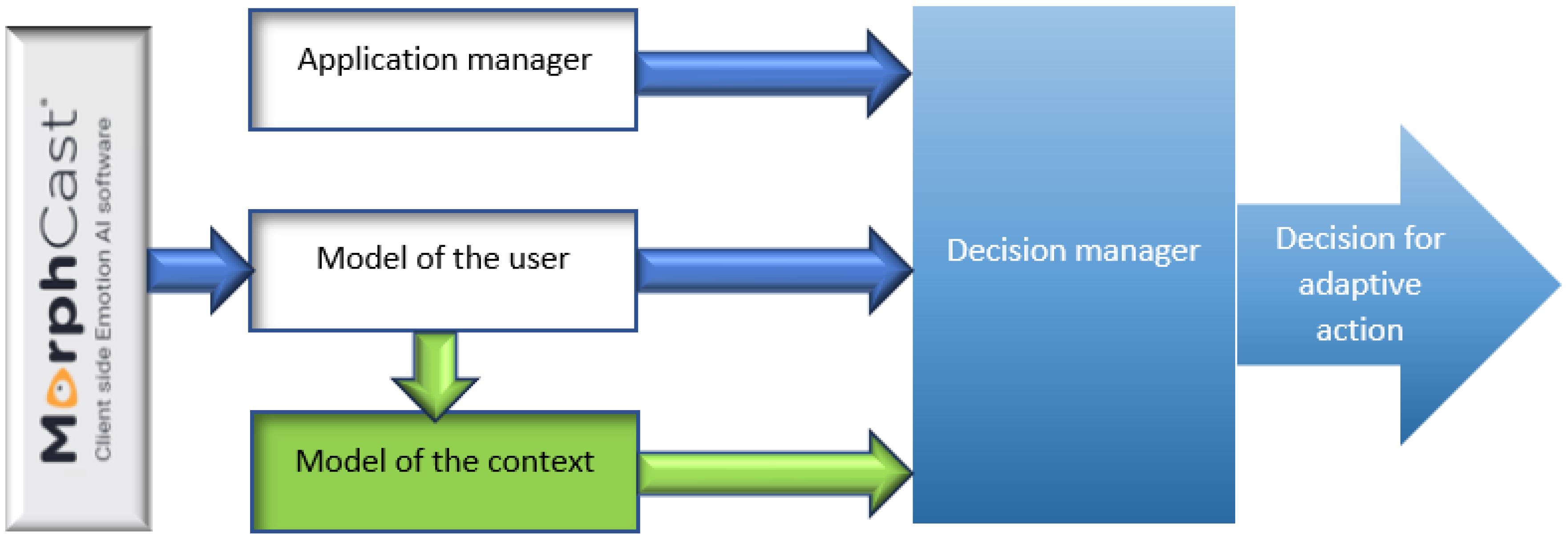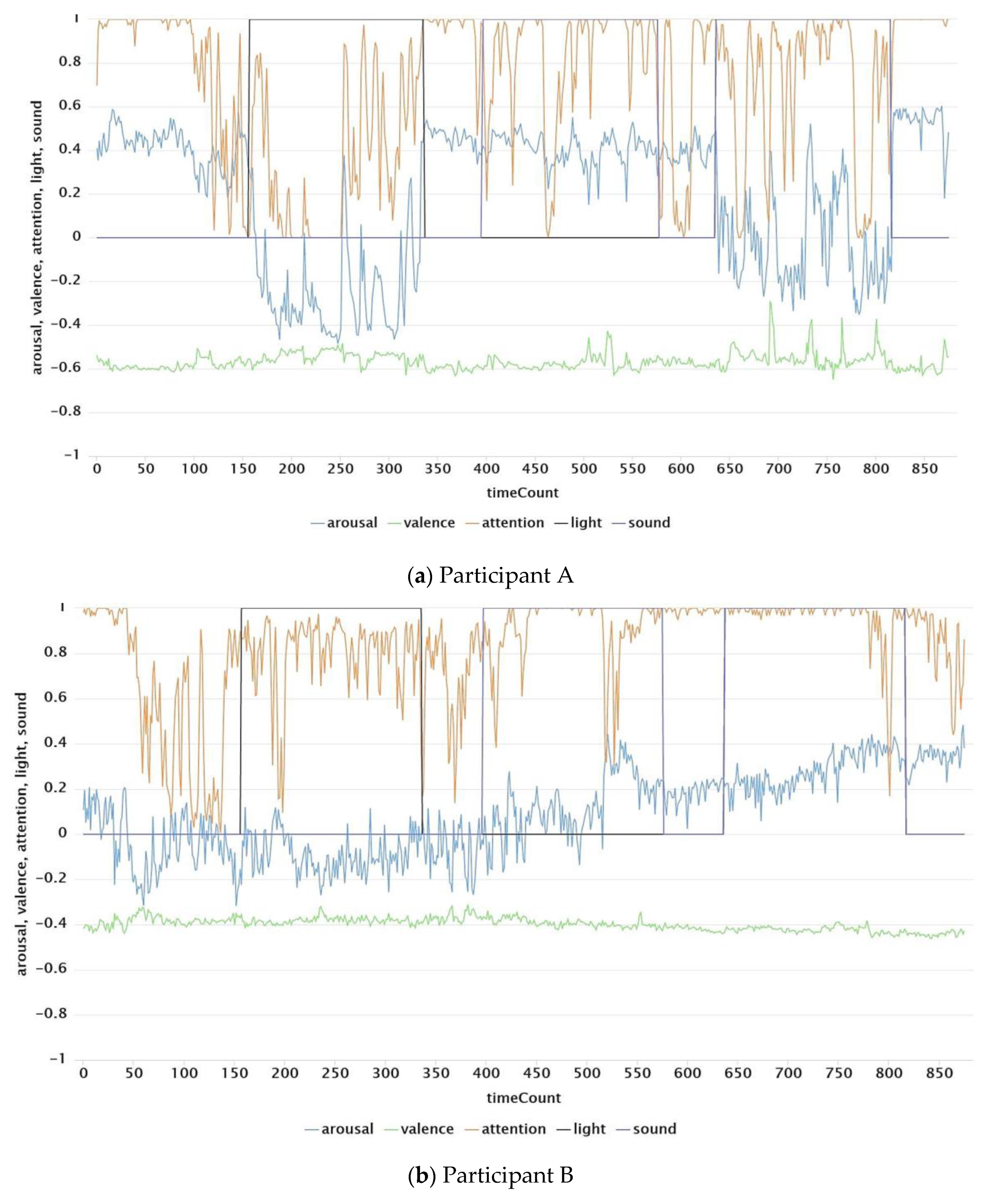Beyond the Physical Environment: Integrating Individual Perception for Context-Related Adaptation †
Abstract
1. Introduction
2. Materials and Methods
2.1. Conceptual Architecture
2.1.1. Context State Recognition
2.1.2. Context Impact Assessment
2.1.3. Context Monitoring and Profiling
2.2. Experimental Setup
3. Results
4. Conclusions
Author Contributions
Funding
Institutional Review Board Statement
Informed Consent Statement
Data Availability Statement
Conflicts of Interest
References
- He, H.; Gray, J.; Cangelosi, A.; Meng, Q.; McGinnity, T.M.; Mehnen, J. The Challenges and Opportunities of Human-Centered AI for Trustworthy Robots and Autonomous Systems. IEEE Trans. Cogn. Dev. Syst. 2022, 14, 1398–1412. [Google Scholar] [CrossRef]
- Rodriguez-Conde, I.; Campos, C. Towards Customer-Centric Additive Manufacturing: Making Human-Centered 3D Design Tools through a Handheld-Based Multi-Touch User Interface. Sensors 2020, 20, 4255. [Google Scholar] [CrossRef] [PubMed]
- Horberry, T.; Mulvihill, C.; Fitzharris, M.; Lawrence, B.; Lenne, M.; Kuo, J.; Wood, D. Human-Centered Design for an In-Vehicle Truck Driver Fatigue and Distraction Warning System. IEEE Trans. Intell. Transport. Syst. 2022, 23, 5350–5359. [Google Scholar] [CrossRef]
- Kardos, C.; Kemény, Z.; Kovács, A.; Pataki, B.E.; Váncza, J. Context-dependent multimodal communication in human-robot collaboration. Procedia CIRP 2018, 72, 15–20. [Google Scholar] [CrossRef]
- Cabrera, O.; Franch, X.; Marco, J. Ontology-based context modeling in service-oriented computing: A systematic mapping. Data Knowl. Eng. 2017, 110, 24–53. [Google Scholar] [CrossRef][Green Version]
- Cabrera, O.; Oriol, M.; Franch, X.; Marco, J. A context-aware monitoring architecture for supporting system adaptation and reconfiguration. Computing 2021, 103, 1621–1655. [Google Scholar] [CrossRef]
- Caro, M.F.; Cox, M.T.; Toscano-Miranda, R.E. A Validated Ontology for Metareasoning in Intelligent Systems. J. Intell. 2022, 10, 113. [Google Scholar] [CrossRef] [PubMed]
- Neszmélyi, B.; Horváth, J. The role of auditory context in action-effect-related motor adaptation. Hum. Mov. Sci. 2019, 67, 102503. [Google Scholar] [CrossRef] [PubMed]
- Markov, M.; Ganchev, T. Intelligent human-machine interface framework. Int. J. Adv. Electron. Comput. Sci. 2022, 9, 41–46. [Google Scholar]
- Feradov, F.; Markova, V.; Ganchev, T. Automated Detection of Improper Sitting Postures in Computer Users Based on Motion Capture Sensors. Computers 2022, 11, 116. [Google Scholar] [CrossRef]
- Markov, M.; Kalinin, Y.; Ganchev, T. A Task-related Adaptation in Intelligent Human-Machine Interfaces. In Proceedings of the International Conference on Communications, Information, Electronic and Energy Systems (CIEES), Veliko Tarnovo, Bulgaria, 24–26 November 2022; IEEE: Piscataway, NJ, USA, 2022; pp. 1–4. [Google Scholar] [CrossRef]
- Markov, M.; Kalinin, Y.; Markova, V.; Ganchev, T. Towards Implementation of Emotional Intelligence in Human–Machine Collaborative Systems. Electronics 2023, 12, 3852. [Google Scholar] [CrossRef]
- Emotion AI Provider. Facial Emotion Recognition, MorphCast (2023). Available online: https://www.morphcast.com (accessed on 22 April 2024).





Disclaimer/Publisher’s Note: The statements, opinions and data contained in all publications are solely those of the individual author(s) and contributor(s) and not of MDPI and/or the editor(s). MDPI and/or the editor(s) disclaim responsibility for any injury to people or property resulting from any ideas, methods, instructions or products referred to in the content. |
© 2024 by the authors. Licensee MDPI, Basel, Switzerland. This article is an open access article distributed under the terms and conditions of the Creative Commons Attribution (CC BY) license (https://creativecommons.org/licenses/by/4.0/).
Share and Cite
Kalinin, Y.; Markov, M. Beyond the Physical Environment: Integrating Individual Perception for Context-Related Adaptation. Eng. Proc. 2024, 70, 29. https://doi.org/10.3390/engproc2024070029
Kalinin Y, Markov M. Beyond the Physical Environment: Integrating Individual Perception for Context-Related Adaptation. Engineering Proceedings. 2024; 70(1):29. https://doi.org/10.3390/engproc2024070029
Chicago/Turabian StyleKalinin, Yasen, and Miroslav Markov. 2024. "Beyond the Physical Environment: Integrating Individual Perception for Context-Related Adaptation" Engineering Proceedings 70, no. 1: 29. https://doi.org/10.3390/engproc2024070029
APA StyleKalinin, Y., & Markov, M. (2024). Beyond the Physical Environment: Integrating Individual Perception for Context-Related Adaptation. Engineering Proceedings, 70(1), 29. https://doi.org/10.3390/engproc2024070029





